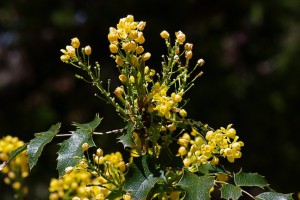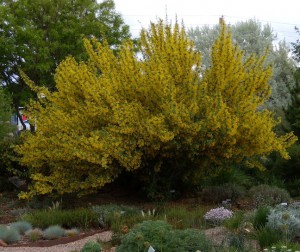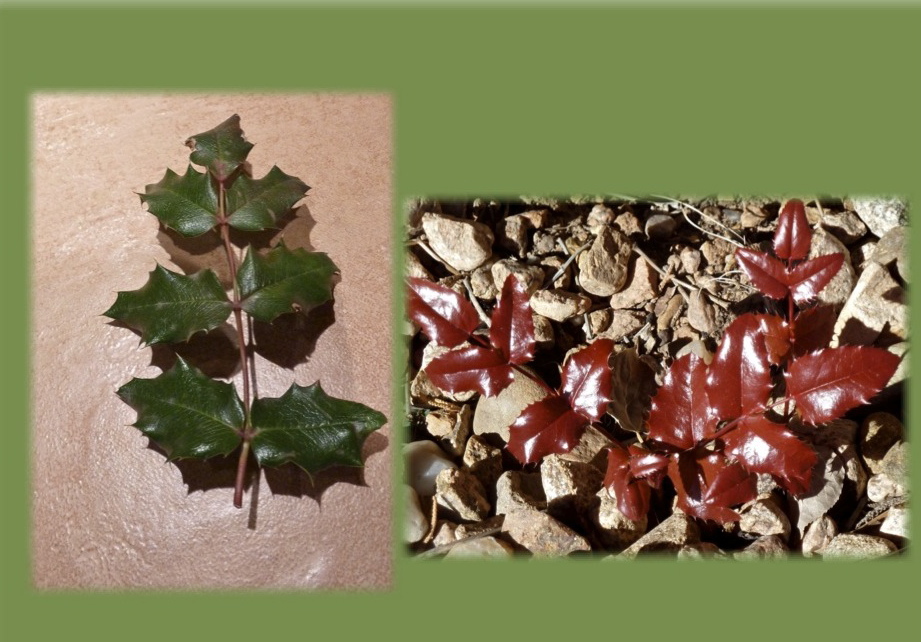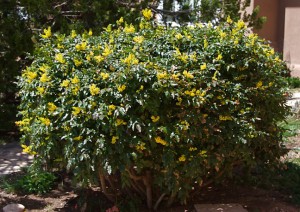Scientific names: Mahonia aquifolium and Mahonia haematocarpa
Plant Family: Berberidaceae – Barberry
Common name: Oregon grape-holly and Red barberry
By Janice Tucker
Deck the halls with boughs of Mahonia!
Um, shouldn’t it be “holly”, not “Mahonia”? Well, since we’re pretty hard-pressed to find a holly in Santa Fe, the Mahonia aquifolium (Oregon grape-holly) and the Mahonia haematocarpa (Red barberry) are good substitutes for decking halls even though the Mahonia is in the Berberidaceae (Barberry) family not the Aquifoliaceae (Holly) family. The species aquifolium is the Roman name for prickly-leaved holly and the species haematocarpa means “blood-red fruit”, referring to its red berries. So either species would certainly qualify for holiday decor when holly is not locally available.
Native to eastern Asia, the Himalayas, North America and Central America, the Mahonia genus is made up of 70 species of evergreen shrubs. Species that grow best in Santa Fe are native to the western and southwestern portions of the United States, southwestern Canada and northwestern Mexico.
The main branches of both of the featured Mahonia are un-branched, rigid and upright, with each branch bearing a multitude of spiny-tipped, odd-pinnately compound leaves. The young, reddish-brown, leaf stems soften to an ash-gray as the plant ages. The M. aquifolim’s leaves are a leathery, glossy green, while the M. haematocarpa’s leaves are more of a matte, gray-green color.

Mahonia aquifolium flower (Photo: Janice Tucker)
The flowers are monoecious (both male and female on the same plant). In early to mid-spring, fragrant, bright yellow, upright flowers bloom in clusters (racemes). The showy flowers sometimes cover the entire plant, often relegating the leaves to a secondary role during the blooming season. The M. aquifolium bears dusty, grape-like berries. The M. haematocarpa produces an abundance of bright red, juicy berries. The berries of both species are edible but very tart, requiring a large quantity of sugar for most tastes. Both species can grow to a height of 12 feet and sometimes taller.
While Mahonia does occur naturally, it is also valued as a plant for home and commercial landscapes. It provides interest year-round from its showy, yellow flowers and coppery, new leaves in the spring to its fruit and scalloped, green leaves throughout the summer and fall. In cold weather, the leaves will take on a purple-red hue with some leaves turning a solid red, resulting in a lovely, bi-color shrub. The M. haematocarpa is on the Santa Fe Botanical Garden at Museum Hill’s plant collection list.

Mahonia haematocarpa (Photo: Tracy Neal)
Nurseries recommend that both of the featured species should be planted in partial shade/partial sun and mildly acidic, neutral or mildly alkaline soil. Water requirements are average but care should be taken to keep the soil from becoming saturated. Despite the recommended planting instructions, the M. aquifolium can be highly adaptable and has been known to flourish in an area that receives full sun and prevailing south winds.
Even though it is not necessary to prune Mahonia, it can be shaped into a small tree. Commercial nurseries can and do propagate by seed, but it can also be propagated by softwood cuttings. Gardeners should wear gloves when handling the sharp, spiny leaves. In fact, when several Mahonia are planted close together they make an effective and formidable barrier hedge. An unsuspecting intruder may rue the day when experiencing an encounter with the knife- tipped leaves.

Mahonia leaves (Photo: Janice Tucker)
The Mahonia genus is named in honor of Bernard M’Mahon (1775-1816), an American horticulturist from Philadelphia. M’Mahon is credited with introducing the Mahonia genus from materials collected by Meriwether Lewis during the Lewis and Clark Expedition.
Ah, but the Mahonia genus is causing a bit of a stir in the Berberidaceae plant family. There is a lively and on-going debate that the Mahonia belongs firmly in the Berberis genus and not as a stand-alone genus. Those opposing the Mahonia as a genus point to the fact that the Berberis and Mahonia genera can hybridize and that their form and structure (morphology) are virtually identical and should therefore be considered one genus and that genus should be Berberis. In addition to that debate, the common name “Oregon grape-holly” (M. aquifolium) is quite misleading, which is not unusual in common plant names. Although it is native to Oregon, it is neither a grape nor a holly but merely resembles those plants in the shape and color of the leaves and fruit respectively. Such debates in the field of botany and taxonomy are not unusual and it is a challenge to stay fully up-to-date on the latest changes in plant names and their classification.

Mahonia aquifolium (Photo: Janice Tucker)
The Plateau Indian tribes used the Oregon grape-holly (M. aquifolium) to treat indigestion. Some extracts from that species have been used as an anti-inflammatory treatment for skin diseases such as eczema and psoriasis. The berries have been used to make red dyes. The berries, which are high in vitamin C, provide food for birds.
While the Mahonia may be a good substitute for holly during the December holidays, it gives pleasure year-round by creating beauty and interest in the garden regardless of the season.


